
What is the significance of Sumo in Japanese society?
Sumo holds significant cultural and historical importance in Japanese society. It is considered Japan’s national sport and embodies traditional values. Sumo rituals reflect Shinto beliefs, emphasizing [censured] and community. The sport promotes discipline, respect, and physical prowess among its practitioners. Sumo tournaments attract large audiences, fostering national pride and unity. Historically, sumo has roots tracing back over 1,500 years. The first recorded sumo match occurred in 23 BCE, showcasing its long-standing presence in Japanese culture. Today, sumo remains integral to Japan’s identity, bridging the past with contemporary society.
How has Sumo evolved throughout Japanese history?
Sumo has evolved significantly throughout Japanese history. It originated as a religious ritual to ensure a good harvest during the Heian period (794-1185). Sumo was initially performed in Shinto shrines and included ceremonial elements. Over time, it transitioned into a competitive sport during the Edo period (1603-1868). The establishment of formal rules and rankings characterized this era. In the Meiji period (1868-1912), Sumo faced modernization and began to adopt Western influences. The sport became more organized, with the formation of the Japan Sumo Association in 1925. Today, Sumo is recognized as a national sport, blending tradition with contemporary entertainment. It retains its cultural significance, showcasing rituals and ceremonies that reflect its historical roots.
What are the key historical milestones in the development of Sumo?
Sumo has a rich history marked by several key milestones. The earliest records of Sumo date back to the 8th century in Japan. During this period, Sumo served as a form of entertainment for the imperial court. In the Edo period (1603-1868), Sumo gained popularity among the general public. This era established many of the rules and rituals still observed today. The formation of the Sumo Association in 1925 was a significant organizational milestone. This association standardized practices and promoted Sumo as a national sport. After World War II, Sumo experienced a resurgence in popularity, becoming a symbol of Japanese culture. The introduction of television in the 1950s further expanded its audience. Each of these milestones contributed to the development and cultural significance of Sumo in Japanese society.
How did Sumo become a national sport in Japan?
Sumo became a national sport in Japan through its historical roots and cultural significance. It originated as a religious ritual over 1,500 years ago, linked to Shinto beliefs. The sport gained popularity during the Edo period (1603-1868), when it was formalized with established rules and tournaments. The Japanese government recognized sumo as a national sport in the late 19th century. This recognition was part of a broader effort to promote Japanese culture. Sumo’s unique traditions and rituals contributed to its status. Today, it remains a symbol of Japanese heritage and national identity.
What cultural values does Sumo represent?
Sumo represents several cultural values in Japan, including respect, tradition, and discipline. Respect is shown through rituals and ceremonies performed before matches. This includes bowing and the purification of the ring. Tradition is vital as sumo has deep historical roots dating back over a thousand years. The sport retains many ancient customs, reflecting Japan’s cultural heritage. Discipline is essential for wrestlers, who undergo rigorous training and adhere to strict lifestyles. This commitment fosters a strong work ethic and personal growth. Sumo also embodies community, as it brings people together during events and ceremonies, promoting social bonds.
How does Sumo embody traditional Japanese values and beliefs?
Sumo embodies traditional Japanese values and beliefs through its rituals, discipline, and respect. The sport is deeply rooted in Shinto traditions, emphasizing purification and offerings to deities. Wrestlers, known as rikishi, follow a strict code of conduct. This code reflects values such as humility, respect for elders, and commitment to training. The ceremonial aspects, like the ring-entering ritual, showcase reverence and tradition. Sumo matches are not just competitions; they are cultural events steeped in history. The sport promotes community and national pride. These elements illustrate how sumo serves as a living representation of Japan’s cultural identity.
What role does Sumo play in community and identity?
Sumo plays a significant role in shaping community and identity in Japan. It serves as a cultural symbol that reflects traditional values. Sumo events foster communal engagement and pride among spectators. The rituals associated with sumo, such as the dohyo-iri, reinforce cultural heritage. Many wrestlers embody local identities, representing their hometowns in competitions. Historical ties link sumo to Shinto practices, enhancing its spiritual significance. The sport also promotes social cohesion through shared experiences during tournaments. Overall, sumo acts as a unifying force within Japanese society.

What rituals are associated with Sumo?
Sumo is associated with several rituals that reflect its cultural significance. The most prominent ritual is the Shinto purification ceremony. This ritual involves the sprinkling of salt in the ring to purify it before matches. Another key ritual is the ring-entering ceremony, known as “dohyo-iri.” This ceremony showcases the wrestlers’ strength and is performed by the highest-ranked rikishi.
Additionally, there are ceremonial offerings made to the deities before tournaments. These offerings often include rice, sake, and vegetables. The wrestlers also perform a series of symbolic movements, such as raising their legs and stomping, to ward off evil spirits.
The rituals are deeply rooted in Shinto beliefs, emphasizing the connection between sumo and [censured]. Historical records indicate that these rituals have been practiced for centuries, linking sumo to Japan’s ancient traditions.
What are the traditional ceremonies performed in Sumo?
Traditional ceremonies performed in Sumo include the Shinto rituals of purification, the ring-entering ceremony (dohyō-iri), and the Yokozuna’s ceremonial performance. The purification ritual involves salt being thrown into the ring to cleanse it. The dohyō-iri is a significant event where wrestlers enter the ring in a formal procession. During this ceremony, the Yokozuna, the highest-ranked wrestler, performs a special ritual, showcasing their status. These ceremonies reflect Sumo’s deep ties to Shinto traditions and Japanese culture. They are integral in maintaining the spiritual significance of the sport.
How do rituals enhance the spiritual aspect of Sumo?
Rituals enhance the spiritual aspect of Sumo by embedding traditional practices that connect wrestlers to Shinto beliefs. These rituals include the purification of the ring, known as the dohyo, which symbolizes a sacred space. Wrestlers perform rituals like salt throwing to purify themselves and the ring before matches. The ceremonial aspects, such as the entrance and the use of ceremonial attire, reflect a deep respect for tradition. Additionally, rituals create a sense of community and continuity within the sport. Historical practices, like the offering of rice to deities, reinforce the spiritual connection to agriculture and prosperity. This blend of physical competition and spiritual ritual elevates Sumo beyond mere sport, making it a cultural expression of Japanese identity.
What is the significance of the Shinto influences in Sumo rituals?
Shinto influences are significant in Sumo rituals as they reflect Japan’s cultural and spiritual heritage. Sumo rituals often include Shinto elements such as purification, offerings, and prayers. The ring, or dohyo, is considered sacred, symbolizing a connection to Shinto deities. Rituals like the shinto-style ring entering ceremony highlight this connection. Wrestlers perform rituals to ensure divine favor and protection. The use of salt for purification is a common practice rooted in Shinto beliefs. Historical texts document the intertwining of Sumo and Shinto, emphasizing their shared origins. This relationship underscores Sumo’s role as not just a sport, but a cultural expression of Japanese [censured].
How do these rituals impact the perception of Sumo in society?
Rituals significantly enhance the perception of Sumo in society. They embody cultural traditions and values that resonate with the Japanese people. These rituals, such as the ring-entering ceremony and the purification rites, symbolize respect and discipline. They reinforce the idea of Sumo as a spiritual and cultural activity, rather than merely a sport. Historical practices, like the use of salt for purification, connect Sumo to Shinto beliefs. This connection elevates Sumo’s status within Japanese heritage. The rituals also foster a sense of community and identity among fans and practitioners. Overall, these elements contribute to a deep respect for Sumo in Japanese culture.
What role do rituals play in audience engagement during matches?
Rituals enhance audience engagement during sumo matches by creating a shared cultural experience. These rituals include the pre-match ceremonies, such as the ring-entering ceremony and the purification rites. They serve to connect spectators with the tradition and history of sumo. The visual spectacle of these rituals captivates the audience’s attention. Additionally, rituals foster a sense of community among fans. They evoke emotional responses, deepening the audience’s investment in the matches. Research shows that participation in these rituals can increase overall enjoyment and satisfaction. Engaged audiences are more likely to attend future matches and support the sport.
How do rituals contribute to the overall experience of Sumo events?
Rituals significantly enhance the overall experience of Sumo events. They create a sense of tradition and cultural identity. Rituals such as the salt purification ceremony symbolize the cleansing of the ring. The pre-match ceremonies build anticipation and excitement among spectators. Rituals also serve to honor the history and heritage of Sumo wrestling. For example, the ceremonial dress of the wrestlers signifies their rank and lineage. Additionally, these rituals foster a communal atmosphere, bringing fans together in shared cultural practices. The incorporation of Shinto elements highlights the spiritual significance of the sport. Overall, rituals are integral to the immersive experience of Sumo events.

What is the contemporary relevance of Sumo in Japan today?
Sumo remains culturally significant in Japan today. It symbolizes traditional values such as discipline, respect, and honor. The sport attracts large audiences, both in-person and through broadcasts. Major tournaments, called honbasho, occur six times a year and draw significant media attention. Sumo wrestlers, or rikishi, are often seen as national icons. They participate in various community events, enhancing Sumo’s connection to Japanese society. Additionally, Sumo promotes physical fitness and wellness among youth. The Japan Sumo Association actively engages in outreach programs to maintain its relevance. Overall, Sumo continues to be a vital part of Japan’s cultural identity.
How does Sumo adapt to modern society?
Sumo adapts to modern society by incorporating contemporary values and practices. It has embraced technology through live streaming and social media to reach a broader audience. Sumo wrestlers now engage in community outreach, promoting health and fitness. The sport has also diversified by allowing foreign wrestlers to compete, reflecting globalization. Additionally, sumo organizations implement stricter safety protocols to ensure wrestler welfare. These adaptations help maintain its relevance in a rapidly changing cultural landscape.
What changes have been made to Sumo practices in recent years?
Recent years have seen several changes in Sumo practices. One significant change is the increased focus on promoting gender equality. Women are now allowed to participate in certain Sumo events, which was previously restricted. Additionally, safety measures have been enhanced to prevent injuries among wrestlers. These measures include stricter regulations on training and match conditions. There has also been a push for modernization in training techniques. This includes incorporating sports science and nutrition into the regimen of wrestlers. Furthermore, the Sumo Association has made efforts to improve the sport’s global appeal. This includes hosting international events and promoting Sumo culture abroad. These changes reflect a broader adaptation to contemporary societal values.
How is Sumo perceived by younger generations in Japan?
Sumo is perceived by younger generations in Japan as a traditional sport facing challenges. Many young people view it as outdated compared to modern sports. Interest in sumo has declined among youth, with fewer attending matches. The sport’s rituals and customs are sometimes seen as irrelevant. However, some appreciate sumo’s cultural significance and history. Social media has helped revitalize interest among certain groups. Events like the Yokozuna’s retirement draw attention from younger fans. Overall, sumo’s appeal remains mixed among the youth demographic.
What challenges does Sumo face in the contemporary world?
Sumo faces several challenges in the contemporary world. The sport struggles with declining participation rates among younger generations. This decline is partly due to the increasing popularity of other sports and activities. Additionally, there are concerns about the aging demographic of current sumo wrestlers. Many wrestlers are retiring without sufficient replacements.
Another challenge is the need to modernize while preserving tradition. Sumo has deep cultural roots, but it must adapt to contemporary societal expectations. Issues such as gender equality are also prominent. Women are still barred from participating in certain aspects of sumo rituals.
Furthermore, the sport faces scrutiny regarding its training practices and health concerns. Reports of injuries and weight management issues have raised alarms. The overall perception of sumo as a sport is also evolving, with some viewing it as outdated.
These challenges require a careful balance between maintaining tradition and embracing necessary changes.
How do societal changes affect the popularity of Sumo?
Societal changes significantly impact the popularity of Sumo. As Japan modernizes, traditional practices like Sumo face challenges. Urbanization leads to a decrease in rural audiences who traditionally supported Sumo. Younger generations show less interest in traditional sports. Changes in entertainment preferences also affect viewership. The rise of technology and digital media shifts attention away from live events. Furthermore, globalization introduces diverse sports, competing for public interest. Economic factors such as recessions can reduce sponsorship and attendance at matches. These societal shifts collectively influence the cultural relevance and popularity of Sumo in contemporary Japan.
What measures are being taken to ensure the future of Sumo?
Measures being taken to ensure the future of Sumo include promoting youth participation and increasing global outreach. Various sumo associations are implementing training programs in schools to attract younger wrestlers. Additionally, international tournaments are being organized to raise awareness and interest in Sumo worldwide. The Japan Sumo Association has also introduced initiatives to enhance the sport’s visibility through social media and broadcasting. These efforts aim to sustain the cultural significance of Sumo while adapting to modern interests.
What can individuals learn from the traditions of Sumo?
Individuals can learn discipline, respect, and cultural heritage from the traditions of Sumo. Sumo emphasizes rigorous training and a strong work ethic, teaching practitioners to commit to their physical and mental development. Respect is a core value, as wrestlers bow to each other and their surroundings, demonstrating humility and acknowledgment of their opponents. The rituals associated with Sumo, such as the Shinto purification rites, highlight the importance of tradition and [censured] in Japanese culture. Furthermore, participants gain insight into teamwork and community, as Sumo training often involves collaboration with stablemates. Overall, Sumo traditions impart valuable life lessons that extend beyond the sport itself.
The main entity of the article is Sumo, Japan’s national sport, which holds significant cultural and historical importance in Japanese society. The article examines the evolution of Sumo throughout history, highlighting key milestones, its role as a national sport, and the cultural values it represents, such as discipline and respect. It also explores the various rituals associated with Sumo, their spiritual significance, and their impact on audience engagement. Additionally, the article addresses contemporary challenges faced by Sumo, including declining interest among younger generations and the need for modernization, while outlining measures to ensure its future relevance in Japanese culture.